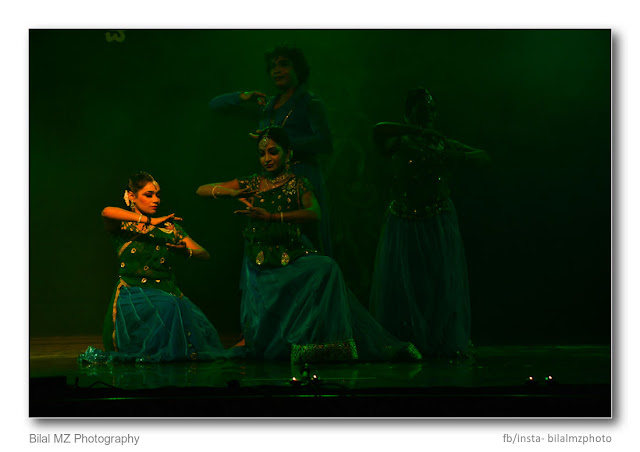Kathak
Kathak is an Indian classical dance form and is considered to be among the top 10 major dance forms of India. The word Kathak is derived from the word Kathakaras which means "storytellers".
The Kathakaras used to visit different villages and courts of kings in ancient times and used to tell stories from Indian epics and mythology in form of dance, songs and music. Later on by the patronage of kings they started settling in courts of kings and the dance form of Kathak was born
This dance performance was captured at Alvas Nudisiri on 19 November 2016. It was performed by the talented Noopur dance company. It was led by Hari and Chetana who are renowned performers nationally and internationally.
I used my Nikon d7100 paired with 18-105 3.5:5.6 lens for capturing this. As the stage lighting was constantly fluctuating, I found it difficult to adjust to a standard-setting. Low light also confused the metering system of the camera. To avoid this confusion, I relied on manual settings throughout the performance. Autofocus too missed many times because of low light.
I used my Nikon d7100 paired with 18-105 3.5:5.6 lens for capturing this. As the stage lighting was constantly fluctuating, I found it difficult to adjust to a standard-setting. Low light also confused the metering system of the camera. To avoid this confusion, I relied on manual settings throughout the performance. Autofocus too missed many times because of low light.
The Mughal era courts and nobles accepted Kathak as a form of aristocratic entertainment, which low-income families were willing to provide. However, the dance became more abstract and erotic, less as a means of communication of spiritual or religious ideas, and in cases, the dancers innovated by emphasizing the eroticism audience wanted while keeping the message such as those of Krishna-Radha embedded in the dance.
Over time, the Kathak repertoire added Persian and Central Asian themes, such as the whirling of Sufi dance, the costumes replaced Saris with items that bared midriff and included a transparent veil of the type common with medieval Harem dancers.When the colonial European officials began arriving in India, the Kathak court entertainment they witnessed was a synthesis of the ancient Indian tradition and Central Asian-Persian dance form, and the Kathak dance performers were called the "nautch girls" (or natch, a derivative of the more difficult to pronounce Sanskrit Natya).
With the spread of colonial British rule in the 19th century India, Kathak along with all other classical dance forms was discouraged and it severely declined. This was in part the result of the Victorian morality of sexual repressiveness along with Anglican missionaries who criticized Hinduism. Kathak was brought to the attention of audiences outside India in the early 20th century through Kalkaprasad Maharaj.
The movement to end the colonial era and for an independent India states Walker, also witnessed a revival of Kathak and more broadly, a cultural ferment and effort to reclaim culture and rediscover history. The Kathak revival movements co-developed in Muslim and Hindu gharanas, particularly by the Kathak-Misra community. Of these, the Jaipur and Lucknow sub-traditions of Kathak have attracted more scholarship. The modern Kathak is a 20th-century phenomenon, more a form of cultural revival.
The costumes vary among Kathak performers and are either Hindu or Muslim. The Hindu costume for female dancers has two variations. One is based on a Sari but is worn in a style different from the customary style that goes over the left shoulder. A Kathak artist generally wraps the sari around the waist and it hangs down from the left. A blouse called choli covers the upper body. The artist may wear a scarf (called Orhni in some places). Hair, face, ear, neck, hand, wrist and ankle jewellery, typically of gold, may adorn the artist. A tika or bindi in the middle of the forehead is common. The second variation of a Hindu Kathak dancer uses a long, full (just above the ankle), light-weight skirt usually with embroidered border that helps highlight the dance moves. The skirt is contrasted with a different colour choli, and a transparent scarf typically drapes over it and the dancer's head. Jewelry is typically present in the second variation.
After the Independence of India, the Kathak was highly patronised as an attempt to save the Indian culture. It was considered as a tradition of India and getting the tradition back into to people was considered very important and it became one of the traditions of the country. Both the Hindu and Muslim communities united to help Kathak grow. This has helped Kathak to be main dance forms in our country.
The Hindu costume for male Kathak performers is typically a silk dhoti draped around the waist, then usually covered with a silk scarf tied on top. The upper body may be bare, show the Hindu thread, or be covered with a loose jacket. Kathak male artists also wear jewellery, but often of stones and much simpler than the female artists.
The Muslim costume for female dancers also uses a skirt, but includes close fitting churidar pyjamas and sometimes a long coat covering hands and the upper body. The head has a cover scarf and the jewellery is light.
Sincere thanks to Dr Krishnamohan (Dr Krishi) for helping me by guiding me in photography.
























Comments
Post a Comment